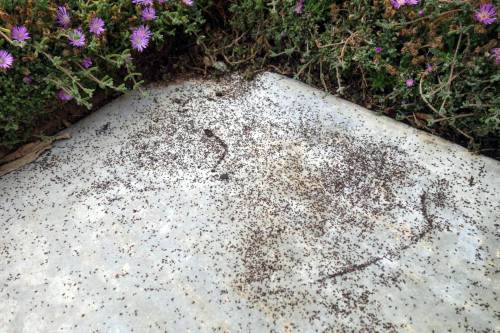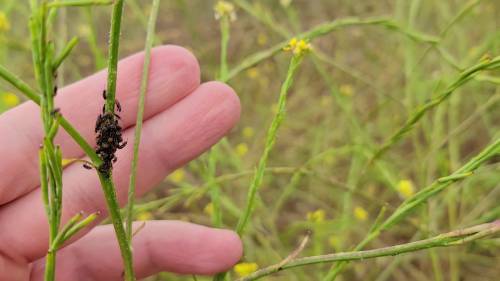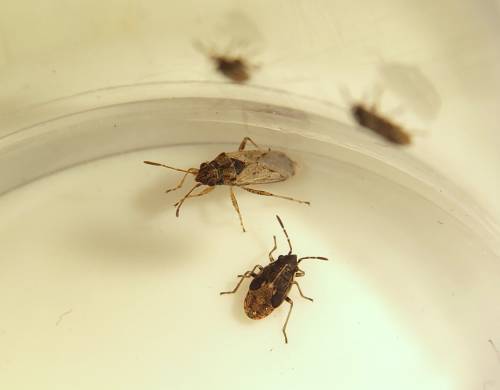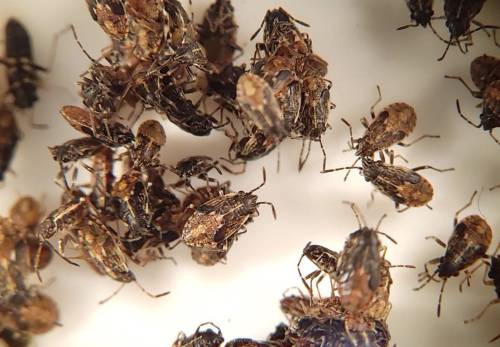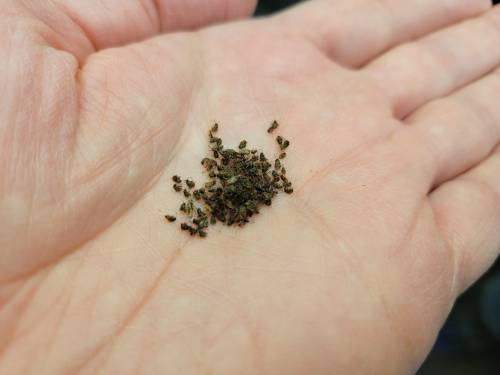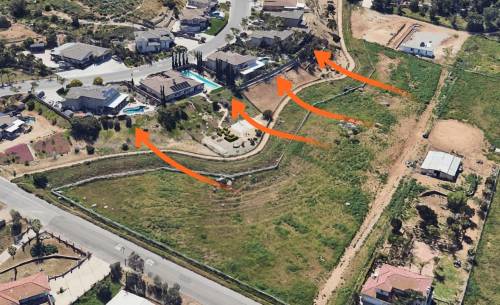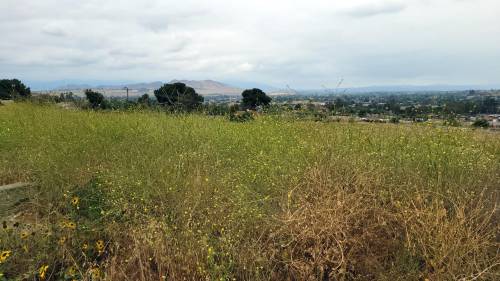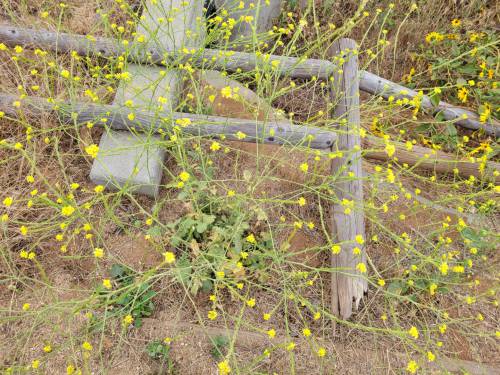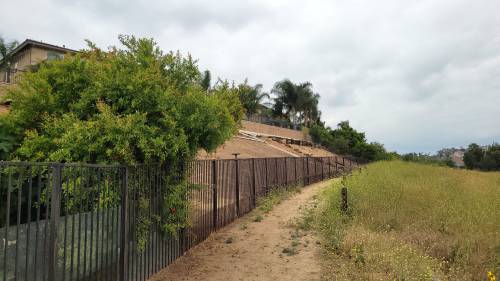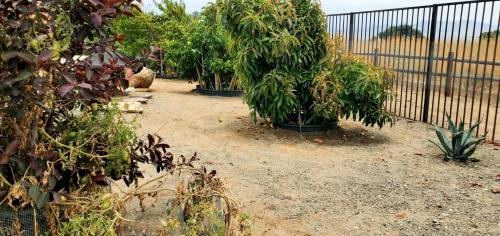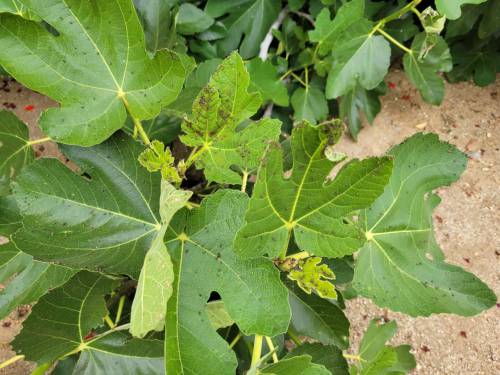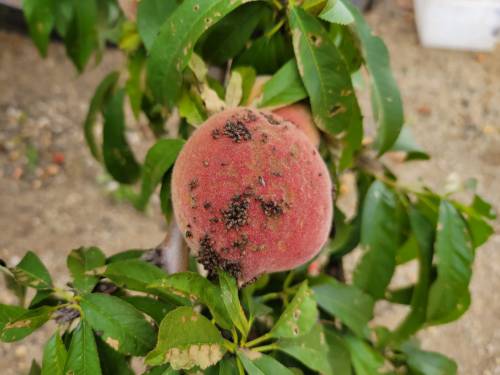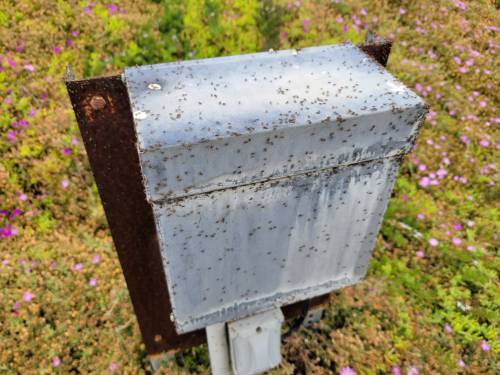The False Chinch Bug As A Structural Pest In Southern California
 Cite
Cite
Many of us love spending time in our backyard or patio gardening, listening to birds singing, or just enjoying drinking coffee or tea while looking at the lawn, trees, or the sky. However, Mother Nature has surprises for us now and then. One of these surprises is when homeowners encounter thousands, if not millions, of bugs crawling onto their patio, exterior doors and windows, fruit trees, outdoor furniture, etc. Here we will discuss the biology and management of the false chinch bug, Nysius raphanus Howard, in Southern California.
Biology
The false chinch bug is an insect with piercing and sucking mouth parts. They primarily feed on mustards from the family Brassicaceae including the London rocket (Sisymbrium irio), Shepherd’s purse (Capsella bursa-pastoris), and shining pepper weed (Lepidium nitidum) (Leigh, 1961). They are well-known to the agricultural world (Leigh, 1961) where they invade farms from surrounding wildlands during spring, after their primary hosts die off. However, they are less known to the pest management professionals (PMPs) and the urban community as a whole. Nevertheless, any unmanaged lot in an urban area can house a large number of wild mustard plants, which in turn can invite false chinch bugs to the area. Mass invasions of FCBs are often associated with wet, cool springs (Haviland & Bentley, 2010).
FCB nymphs have a mottled orange and white abdomen on the dorsal side with gray to black stripes on their head and thorax. Adult FCBs are dark in color and fully winged. Similar to stink bugs, adult FCB wings are half leathery and half membranous (hemelytra).
FCBs have five nymphal stages (Howard, 1872 as mentioned in Demirel & Cranshaw, 2006b). FCB females lay eggs in cracks in the ground or around the base of host plants. Population can overwinter as eggs, nymphs, as well as adults (Whitworth et al., 2012). In the Spring, FCBs reproduce on their host plant and may aggregate in large numbers on plants, walls, and outdoor objects when their host plants die.
Adult FCBs have been observed to fly between one to four meters above the ground (McPherson & Weber, 1990). During invasions, however, adults prefer to march from wild plants to adjacent areas along with wingless nymphs (Haviland et al., 2005).
Invasion pattern
Here is a common scenario in which millions of these bugs can invade an urban area. Winter and spring rains promote the growth of various mustard species, on which false chinch bug populations grow to exponential levels. In a few months, the rainy season ends, and mustard plants start to die off. This leaves the FCBs without food which forces them to migrate from unmanaged or natural areas to farms and residential properties. This is when the surprise happens: Residents may see millions of tiny bugs crawling on every surface and object including the driveway, sidewalks, patio furniture, ornamental plants, fruit trees, vegetables, walls, doors and windows, etc. The bugs can even fall into pools and other water bodies creating dark patches on the surface and eventually on the bottom of water after getting drowned. During an invasion, the outdoor spaces become unusable to the residents as these bugs can crawl onto the legs and arms of anyone sitting outside and also because they produce a pungent defensive chemical, similar to stink bugs. The problem gets worse when these bugs find their way inside homes through gaps around windows, doors, or exterior walls.
Although temporary in nature, such invasions may become intolerable to residents and require constant cleaning of the outdoor and indoor spaces. These invasions may last a few days to weeks, depending on the weather and the size of the FCB population.
Jurupa Valley case
On May 30th,2023, we received a request from a resident in Jurupa Valley - California, about a massive bug infestation in a street block coming from an unmanaged adjacent lot. The bugs were coming from dying weeds next door which were identified as the shortpod mustard (Hirschfeldia incana), an invasive plant native to the Mediterranean region. This is a highly branched, annual to short-lived perennial mustard species with yellow flowers and short seed pods that are appressed to stems (CAL-IPC). After visiting two properties and sampling the infestation, the bugs were identified as the false chinch bug (Nysius raphanus). On one of the inspected properties, many thousands of live and dead FCBs were visible along sidewalks at the edge of planted soil, in the pool, and on almost every single object, fruit tree, and ornamental plant. The homeowner stated that they and their neighbors started noticing the bugs around May 18th, 2023, and that the problem was eventually resolved in about eight weeks total, (or six weeks after the first author inspected the place). Since the onset of the problem, the residents on the block constantly cleaned the outdoor space around the home to remove the dead bugs, but new bugs kept coming. The resident of the first property inspected applied an insecticide containing 2.5% permethrin to the hardscape to kill and prevent new bugs from coming in but to no avail. Others hired pest control companies but more bugs kept coming in every day. All the houses on the block were on a steep slope facing an unmanaged lot. Part of the adjacent lot was public and the rest of it was a privately-owned horse ranch. A trail separated the property lines from the unmanaged lot. According to one of the residents, the bugs also annoyed some of the trail visitors while jogging on the trail. All eight houses on the block were experiencing the bug problem. The closest distance between the wild host plants and the perimeter walls of the first house inspected was around 30 m (98 ft.), with landscaped areas all in between. Therefore, all the FCBs had to walk uphill to reach the perimeter walls and the pool. The second inspected house had no landscaping on the slope and yet FCBs managed to reach the perimeter of the house by crossing bare soil and climbing a vertical retainer wall.
We estimate that at least 50 thousand visible live and dead FCBs were present on the first property inspected excluding those hidden under bushes, hardscape, and those in the pool. This is based on the observation that one square centimeter (~0.15 sq. in.) of concrete can house around 20 FCBs (unpublished data). Furthermore, the total length of soil bordering sidewalks and stairs made of concrete or stone where most of the dead or dying FCBs were seen was measured to be 178 meters (583 ft.). Therefore, assuming a 1 cm wide accumulation of bugs, a conservative estimate of the total number of FCBs invading the first property over the course of 8 weeks would be over one million. The lot size of the property inspected and used for this calculation was about 2,301 sq. m. (24,775 sq. ft.) based on Google Earth measurements.
Monitoring
FCB population in natural areas can be monitored using visual inspection of the host plants or by using yellow sticky traps to capture and count the bugs. One study on FCBs revealed that they are most attracted to the yellow color (Demirel & Cranshaw, 2006c), similar to many other insects. One way to trap and monitor them is to use a yellow sticky card mounted on a wood stick positioned approximately 23 inches (60cm) above the ground (Demirel & Cranshaw, 2006c). Monitoring allows one to predict the exact timing of the mass invasion of FCB ahead of time and take appropriate measures accordingly.
Management
Any FCB mass invasion indicates that it is already too late to do preventative pest control work. Residents usually seek immediate control, but the sheer number of bugs invading makes it very difficult to effectively manage them. Nevertheless, there are several methods for controlling the false chinch bug and they all fall under the following categories: 1-Methods for managing the host weeds and 2-Methods for managing the FCBs.
Methods for managing the host weeds
The host plants of the false chinch bugs can be controlled using a variety of methods. If host plants are kept in low numbers, then the population of the FCB will never grow to exponential levels. Killing the host plants must be done either early season or must be accompanied by the removal of the bugs if it is being done later in the season.
Physical control can be accomplished through pulling, cutting, or mowing the weeds. For a homeowner, pulling can be effective in small patches and on small plants, but is time-consuming. Pulling is usually done too late in the season when the mustards have begun to flower and FCB populations may already be large. Tools, like a hoe, would be more effective than hand pulling and can be used early in the season before mustard plants grow large. On large mustard populations, plants will likely be efficiently controlled with mowers or string trimmers. It will often take multiple mowings to keep the mustard plants under control. Some mustard species grow close to the soil surface and may be difficult to mow for most of the growing season, and mowing may not effectively reduce their populations.
Controlling the host plants using a post-emergent herbicide, early in the growing season, can starve the bugs and prevent them from building large populations. Post-emergent herbicides known to work well on mustards include glyphosate (E.g., Roundup and many other brands), triclopyr (E.g., such as Garlon 4 Ultra), chlorsulfuron (such as Telar XP), and 2,4-D (numerous brands) (DiTomaso et al., 2013). However, if the bug population is already large, killing the host plants may make things worse by forcing the majority of FCBs to suddenly migrate to adjacent properties. A pre-emergent herbicide can be applied in the late fall or early winter to prevent the establishment of mustards. A wide variety of pre-emergent products are available for use in residential areas, with fewer pre-emergent products available in natural or disturbed areas. If applicable, check labels to ensure that nearby non-target plants will not be affected. Also, ensure the product label allows for herbicide application at that specific site. Many herbicides that are labeled for use on disturbed sites, for example, in fallow fields, may not be labeled for use in residential sites.
Tilling or disturbing the soil using a tractor or harrow can be effective as it will destroy the food source and most of the bugs by burying them under the soil. However, many mustards thrive in disturbed soil, and without consistent control, future weed populations can increase even more, making the problem worse. Mulch can be an effective method of preventing mustards from getting established on bare or disturbed soils but can be difficult or expensive to apply to large areas.
The pesticide applicator needs to follow all the local, state, and federal pesticide application label laws at all times.
Methods for managing the FCBs
FCBs can be managed using mechanical or chemical methods. The bugs can be trapped on a sticky shield using beating. This is similar to using a beater (a stick) and a beating sheet to dislodge and catch bugs, except that it uses a sticky surface instead of a piece of heavy-duty cloth. The shield consists of a board covered with sticky oils and chicken wire spaced about four inches from the sticky surface to prevent stems and other large debris from getting stuck on the sticky surface, reducing the efficacy of trapping (Milliken, 1916). Crude petroleum or products such as Tanglefoot can be spread on the board to make it sticky. The sticky surface must be renewed as needed. Trapping FCBs using the sticky shield is only practical for small-scale jobs as it is a very laborious and time-consuming process.
Insecticides can be applied directly to the host plant or as a perimeter barrier to the building. Treating the bugs on the host plant is advantageous as it kills them in their origin before they start moving to adjacent properties. However, such applications are not known to provide adequate control unless large areas are treated with insecticides. FCB is shown to be susceptible to many active ingredients such as diazinon, chlorpyrifos, cyfluthrin, lambda-cyhalothrin, permethrin, imidacloprid, thiamethoxam, and spinosad (Demirel, 2007). In one study, FCB numbers were reduced by 91% and 85.5% at 12 and 15 days after being exposed to polypropylene mesh bags treated with 0.01% permethrin residues (Demirel & Cranshaw, 2006a). Nevertheless, different insect populations may show a different response to each insecticide. Similar to herbicides, applying insecticides on adjacent lands may require special permits or authorization from the owners.
A perimeter barrier spray using residual insecticides can kill or repel incoming FCBs, but the barrier must be renewed regularly until the problem gets fully resolved for the season. The sheer number of bugs invading a property can easily render a perimeter insecticide treatment ineffective. For treating concrete and other porous materials such as bricks and stones, it is highly recommended to use a product with a wettable powder formulation or a product with micro-encapsulated technology to maintain a high surface activity of the product. Other formulations such as emulsifiable concentrate only provide short-term control as most of the chemicals quickly get absorbed into the hardscape, leaving very little active ingredient on the surface to kill the insects (Arthur, 1994).
Acknowledgements
We would like to thank David Haviland (Farm Advisor, UCCE-Kern County) for his guidance on the biology and management of FCBs.
References:
- Arthur, F. H. (1994). Residual efficacy of cyfluthrin emulsifiable concentrate and wettable powder formulations on porous concrete and on concrete sealed with commercial products prior to insecticide application. Journal of Stored Products Research, 30(1), 79–86. https://doi.org/10.1016/0022-474X(94)90276-3
- CAL-IPC. (n.d.). Hirschfeldia incana profile. https://www.cal-ipc.org/plants/profile/hirschfeldia-incana-profile/
- Demirel, N. (2007). Mortality of false chinch bug, Nysius raphanus (Howard). Journal of Entomology, 4(2), 155–159.
- Demirel, N., & Cranshaw, W. (2006a). Permethrin treatment of pollination bags as a protecting from false chinch bug, Nysius raphanus (Howard) (Hemiptera: Lygaeidae), injury to canola in Colorado. Crop Protection, 25(9), 1062–1064. https://doi.org/10.1016/j.cropro.2006.01.009
- Demirel, N., & Cranshaw, W. (2006b). Plant yield response to artificial infestation of the false chinch bug,Nysius raphanus, confined on spring canola. Phytoparasitica, 34(5), 477–485. https://doi.org/10.1007/BF02981202
- Demirel, N., & Cranshaw, W. (2006c). Relative attraction of color traps and plant extracts to the false chinch bug Nysius raphanus and its parasitoid, Phasia occidentis, on brassica crops in Colorado. Phytoparasitica, 34(2), 197–203. https://doi.org/10.1007/BF02981320
- DiTomaso, J. M., Kyser, G. B., Oneto, S. R., Wilson, R. G., Orloff, S. B., Anderson, L. W., Wright, S. D., Roncoroni, J. A., Miller, T. L., & Prather, T. S. (2013). Weed control in natural areas in the western United States. Weed Research and Information Center, University of California, 544.
- Haviland, D., & Bentley, W. (2010). False chinch bug. https://ipm.ucanr.edu/legacy_assets/pdf/pestnotes/pnfalsechinchbug.pdf
- Haviland, D., Bentley, W., & Weber, E. (2005). False Chinch Bug. https://cekern.ucanr.edu/Entomology/Newsletters_and_Other_Entomology_Information_114/False_Chinch_Bug/
- Howard, W. R. (1872). The radish bug-new insect (Nysius raphanus, n. Sp). Can. Entomol, 4, 219–220.
- Leigh, T. F. (1961). Insecticidal Susceptibility of Nysius raphanus, a Pest of Cotton. Journal of Economic Entomology, 54(1), 120–122. https://doi.org/10.1093/jee/54.1.120
- McPherson, J. E., & Weber, B. C. (1990). Seasonal flight patterns of Hemiptera (excluding Miridae) in a southern Illinois black walnut plantation. The Great Lakes Entomologist, 23(2), 6.
- Milliken, F. B. (1916). The False Chinch Bug and Measures for Controlling it. U.S. Department of Agriculture.
- Whitworth, R. J., McCornack, B., & Davis, H. (2012). False Chinch Bug. MF3047. https://entomology.k-state.edu/doc/extension-crop-pests/mf3047fcb.pdf


